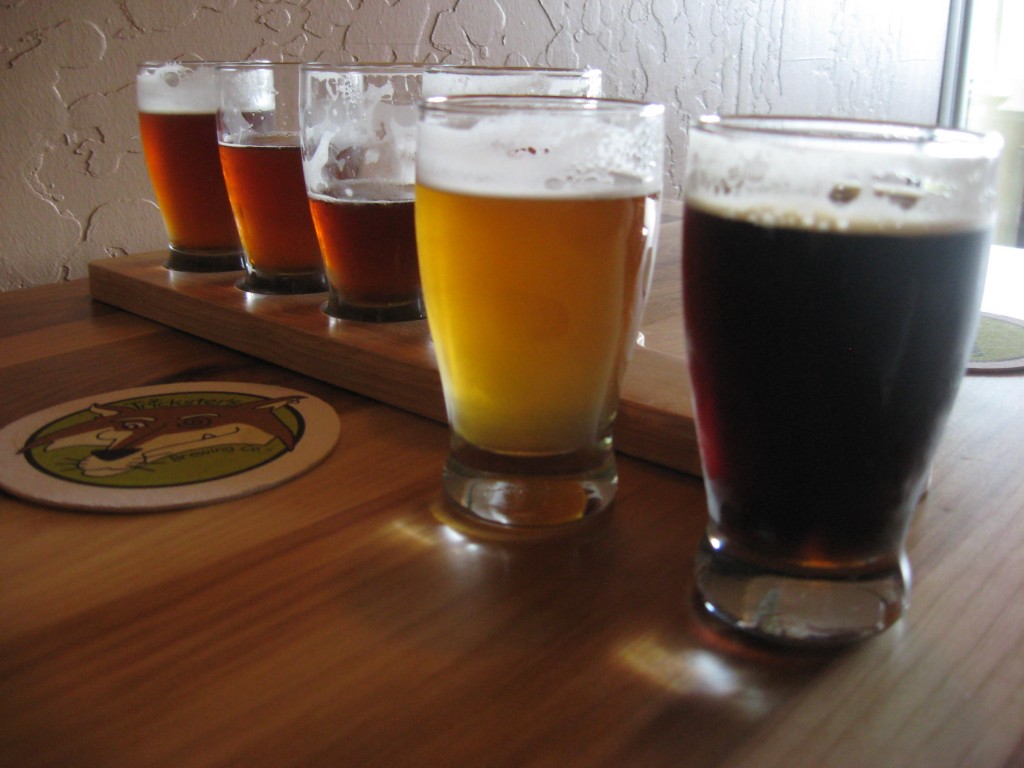
Oregon Congressman and co-chair of House Small Brewers Caucus
with the Widmer brothers during a visit to their Portland brewery.
Photo courtesy House Small Brewers Caucus
 Written by Charlie Papazian for Examiner.com
Written by Charlie Papazian for Examiner.com
This story started out with link sent to me from House Small Brewers Caucus co-chairman Congressman Peter DeFazio’s Legislative Aide, Ed Hill. “Indie Hops puts new plant to work with a tip toward craft brewers.â€Â A story special to The Oregonian.
It’s a short piece published in late April about a new hop pelletizing plant in Hubbard, Oregon. Hop pelletizing grinds, compresses and extrudes dried hops into pellets, resembling rabbit food. During the high volume methods of pelletizing temperatures can reach 140 to 150 degrees F. Heat damages the delicate aroma and flavor qualities of hops. Jim Solberg, CEO of Indie Hops, hop growers and processor claims that the lower temperature process will help preserve more of the flavors and aromas craft brewers are seeking. Founded in 2008, Indie Hops provides an infrastructure and supplies Oregon-grown aroma hops to craft brewers while partnering with leading farmers in the Willamette Valley.
It got me to thinking about all the stories I had heard of new hop farming emerging during the hop crisis of 2008. A rather quick search of the internet revealed several hop farms have no new news to report since they dove into rush to hops in 2008. But surprisingly there is plenty of evidence hop farming is alive and well in several parts of the USA. Their overriding goal seems to provide local hops to local craft brewers.
 Hop farming is a tough business. Hops are extremely susceptible to blights; weather, insects and fungus have ravaged hop growing areas for centuries. In the late 19th century New York State was one of the world’s premier hop growing and producing areas. It got hit with a fungus that totally devastated New York State hop farming. Everywhere in the world pesticides and fungicides are usually used to enable economically sustainable yields of hop crops. Only hops from New Zealand are grown “organically†on a large scale. Crop destroying insects and fungus have not arrived in New Zealand yet. Nor have they arrived at America’s newer small and independent hop farms. See Hops have brains too
Hop farming is a tough business. Hops are extremely susceptible to blights; weather, insects and fungus have ravaged hop growing areas for centuries. In the late 19th century New York State was one of the world’s premier hop growing and producing areas. It got hit with a fungus that totally devastated New York State hop farming. Everywhere in the world pesticides and fungicides are usually used to enable economically sustainable yields of hop crops. Only hops from New Zealand are grown “organically†on a large scale. Crop destroying insects and fungus have not arrived in New Zealand yet. Nor have they arrived at America’s newer small and independent hop farms. See Hops have brains too
Photo left courtesy of Indie Hops. Hops emerge in early spring
Hop harvesting, drying and processing equipment is extremely expensive and only in use for about 4 to 10 weeks, depending on varieties planted. Hand picking on a commercially viable basis is almost impossible.
Here are a few stories and links to small hop farming activities recently established. Some farmers are making progress at making a run at sustainable harvests, two years into their endeavors. One has to admire their ballsy endeavors and passion for offering the craft and homebrewing community a local option.
2008 background story: Small Brewers Turn to Hop Farming

Blue Mountain Brewery and Hop Farm
Rhode Island
Ocean State Hops
New York
Hops in Upstate New York: It’s a small but growing industry
Pompey Mountain Hops
Foothills Hops
Pedersen Farms
Photo right courtesy of Ocean State Hops
Oregon
Man leaves job, takes a leap of faith to grow hops
Wisconsin
Gorst Valley Hops
Simple Earth Hops at Greensspirit Farm CSA
An additional resource for hop growing activities: Madison Hops Examiner’s Articles Matt Sweeny Madison Hops Examiner
Colorado
Colorado Organic Hops
For more information about the House Small Brewers Caucus click through link. Is your Congressional Representative a member of the House Small Brewers Caucus?

